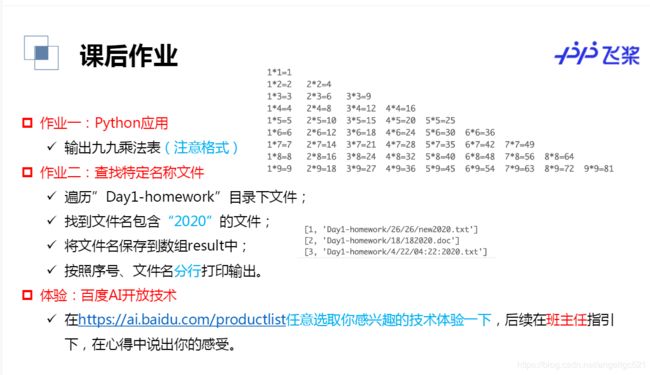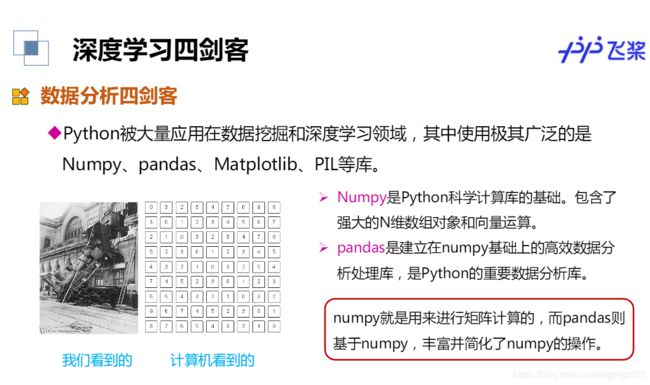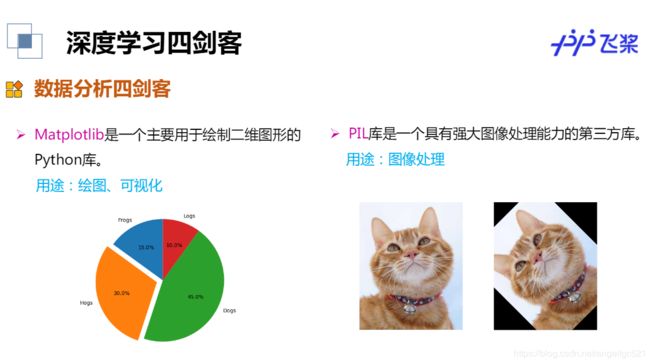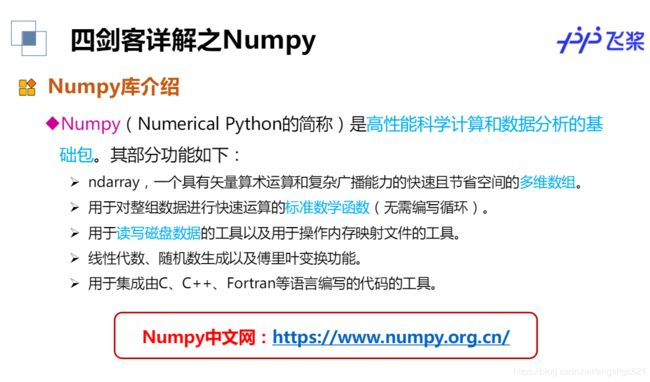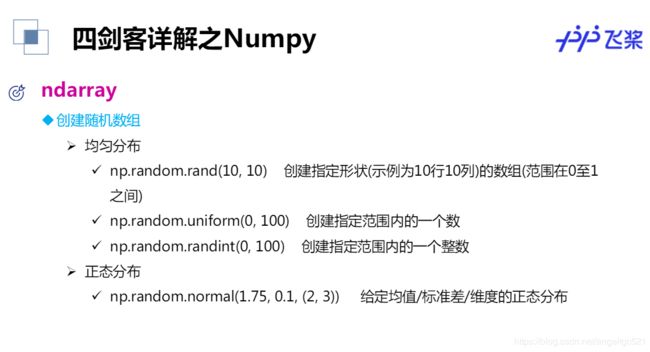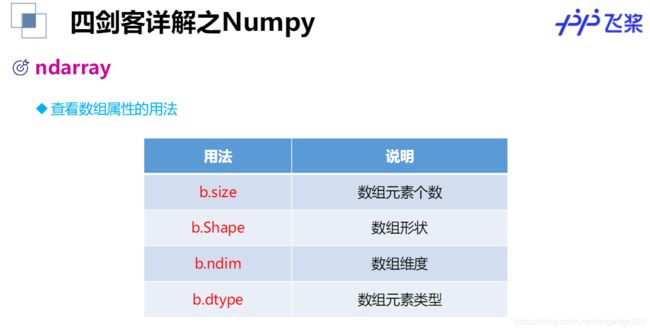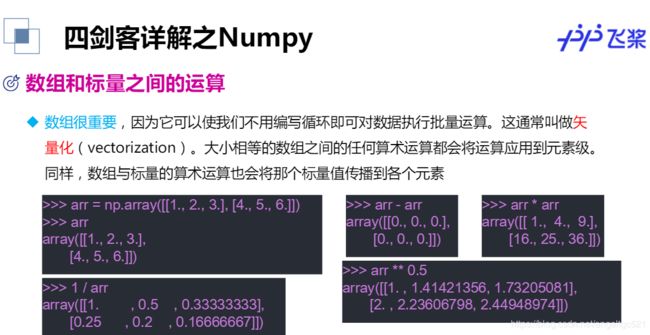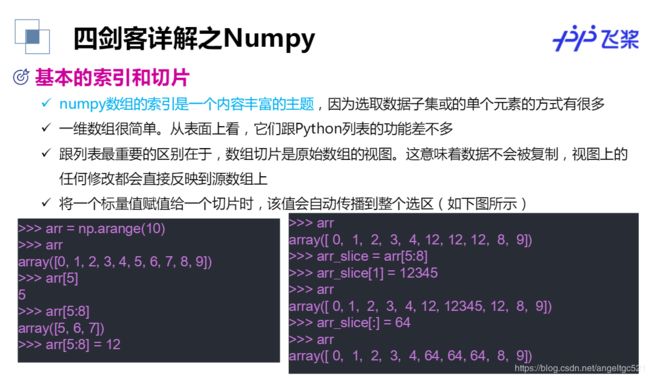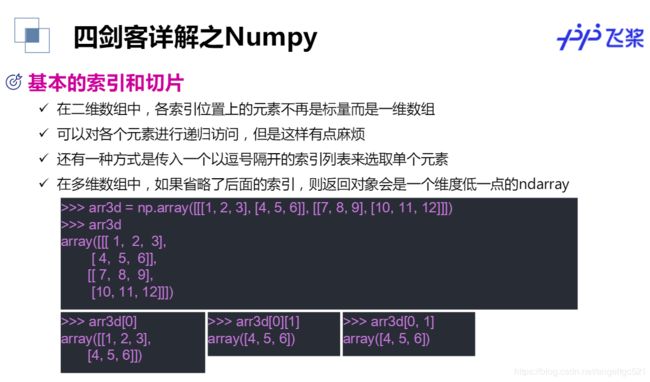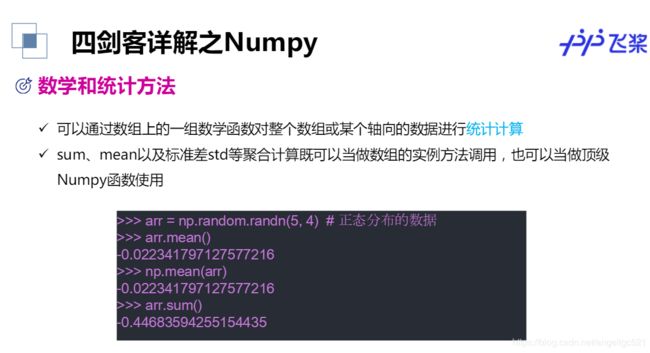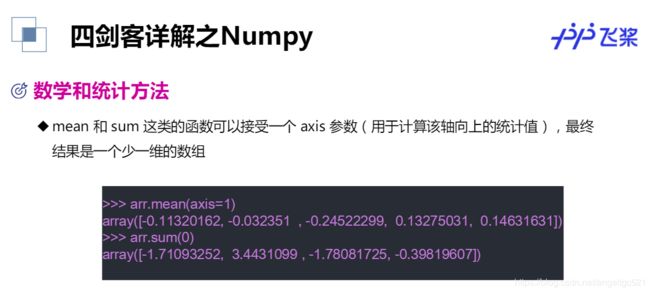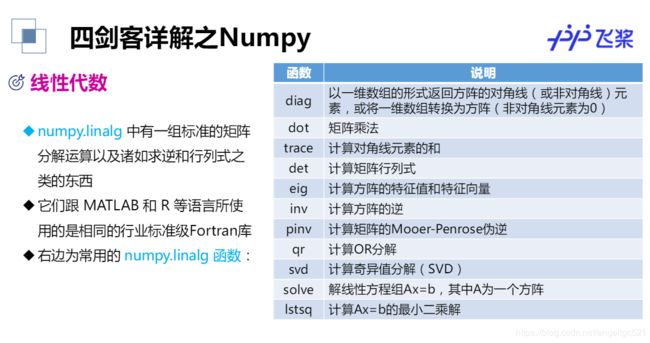第一天
python基础
第一天讲一些Python入门学习,数据类型、循环的操作以及人工智能概述。
1.基础操作
age = 20 # 声明一个变量age 用来存储一个数字 20
1+1 # 基础数学加法
print('Hello World!') # 打印Hello World!
2.条件判断if
if 1 == 2: # 如果 if 跟随的条件为 假 那么不执行属于if 的语句,然后寻找 else
print("假的")
else: # 寻找到 else 之后 执行属于else中的语句
print("1==2是假的")
3.循环操作—for
for i in range(5):
print(i)
3.循环操作—while
sum = 0
n = 99
while n > 0:
sum = sum + n
n = n - 1
print(sum)
4.break、continue、pass
break语句可以跳出 for 和 while 的循环体
n = 1
while n <= 100:
if n > 10:
break
print(n)
n += 1
continue语句跳过当前循环,直接进行下一轮循环
n = 1
while n < 10:
n = n + 1
if n % 2 == 0:
continue
print(n)
pass是空语句,一般用做占位语句,不做任何事情
for letter in 'Room':
if letter == 'o':
pass
print('pass')
print(letter)
5.数据类型—Number(数字)
Python支持int, float, complex三种不同的数字类型
a = 3
b = 3.14
c = 3 + 4j
print(type(a), type(b), type(c))
5.数据类型—String(字符串)
支持字符串拼接、截取等多种运算
a = "Hello"
b = "Python"
print("a + b 输出结果:", a + b)
print("a[1:4] 输出结果:", a[1:4])
5.数据类型—Tuple(元组)
tuple与list类似,不同之处在于tuple的元素不能修改。tuple写在小括号里,元素之间用逗号隔开。元组的元素不可变,但可以包含可变对象,如list。
t1 = ('abcd', 786 , 2.23, 'runoob', 70.2)
t2 = (1, )
t3 = ('a', 'b', ['A', 'B'])
t3[2][0] = 'X'
print(t3)
5.数据类型—dict(字典)
字典是无序的对象集合,使用键-值(key-value)存储,具有极快的查找速度。
d = {'Michael': 95, 'Bob': 75, 'Tracy': 85}
print(d['Michael'])
5.数据类型—set(集合)
set和dict类似,也是一组key的集合,但不存储value。由于key不能重复,所以,在set中,没有重复的key。
s = set([1, 1, 2, 2, 3, 3])
print(s)
第一天作业 答案:
for x in range(1,10):
for y in range(1,x+1):
print("%s*%s=%s" % (y,x,x*y),end=" ")
print("")#print默认参数"换行",没有此条语句输出打印时将不会换行
结果展示
1*1=1
1*2=2 2*2=4
1*3=3 2*3=6 3*3=9
1*4=4 2*4=8 3*4=12 4*4=16
1*5=5 2*5=10 3*5=15 4*5=20 5*5=25
1*6=6 2*6=12 3*6=18 4*6=24 5*6=30 6*6=36
1*7=7 2*7=14 3*7=21 4*7=28 5*7=35 6*7=42 7*7=49
1*8=8 2*8=16 3*8=24 4*8=32 5*8=40 6*8=48 7*8=56 8*8=64
1*9=9 2*9=18 3*9=27 4*9=36 5*9=45 6*9=54 7*9=63 8*9=72 9*9=81
作业二:查找特定名称文件
遍历”Day1-homework”目录下文件;
找到文件名包含“2020”的文件;
将文件名保存到数组result中;
按照序号、文件名分行打印输出。
注意:提交作业时要有代码执行输出结果。
#导入OS模块
import os
#待搜索的目录路径
path = "Day1-homework"
#待搜索的名称
filename = "2020"
#定义保存结果的数组
result = []
index =0
def findfiles(path):
#在这里写下您的查找文件代码吧!
#
dir_list =os.listdir(path)
#print(dir_list)
for i in dir_list:
path_temp = i
path_name = os.path.join(path,i)
#print(path_temp)
#print(path_name)
#print(path)
global index
if os.path.isdir(path_name):
findfiles(path_name)
elif os.path.isfile(path_name):
#print(path_temp.find(filename))
if(path_temp.find(filename) != -1):
result =[]
#print(index)
index = index +1
result.append(index)
#print(index)
result.append(path_name)
if (len(result) > 0):
print(result)
if __name__ == '__main__':
findfiles(path)
结果展示
[1, 'Day1-homework/4/22/04:22:2020.txt']
[2, 'Day1-homework/26/26/new2020.txt']
[3, 'Day1-homework/18/182020.doc']
第二天
python进阶学习
1. Python数据结构
数字
Python Number 数据类型用于存储数值。
Python Number 数据类型用于存储数值,包括整型、长整型、浮点型、复数。
(1)Python math 模块:Python 中数学运算常用的函数基本都在 math 模块
(2)Python随机数 :首先import random,使用random()方法即可随机生成一个[0,1)范围内的实数
字符串
字符串连接:+ 重复输出字符串: 通过索引获取字符串中字符[] 判断字符串中是否包含给定的字符: in, not in 字符串截取[:] 牢记:左开右闭 join():以字符作为分隔符,将字符串中所有的元素合并为一个新的字符串 三引号让程序员从引号和特殊字符串的泥潭里面解脱出来,自始至终保持一小块字符串的格式是所谓的WYSIWYG(所见即所得)格式的。
列表
作用:类似其他语言中的数组
声明一个列表
names = ['jack','tom','tonney','superman','jay']
通过下标或索引获取元素
print(names[0])
print(names[1])
获取最后一个元素
print(names[-1])
print(names[len(names)-1])
获取第一个元素
print(names[-5])
遍历列表,获取元素
for name in names:
print(name)
查询names里面有没有superman
for name in names:
if name == 'superman':
print('有超人')
break
else:
print('有超人')
更简单的方法,来查询names里有没有superman
if 'superman' in names:
print('有超人')
else:
print('有超人')
列表元素添加
声明一个空列表
girls = []
append(),末尾追加
girls.append('杨超越')
print(girls)
extend(),一次添加多个。把一个列表添加到另一个列表 ,列表合并。
models = ['刘雯','奚梦瑶']
girls.extend(models)
#girls = girls + models
print(girls)
insert():指定位置添加
girls.insert(1,'虞书欣')
print(girls)
列表元素修改,通过下标找到元素,然后用=赋值
fruits = ['apple','pear','香蕉','pineapple','草莓']
print(fruits)
fruits[-1] = 'strawberry'
print(fruits)
将fruits列表中的‘香蕉’替换为‘banana’
for fruit in fruits:
if '香蕉' in fruit:
fruit = 'banana'
print(fruits)
for i in range(len(fruits)):
if '香蕉' in fruits[i]:
fruits[i] = 'banana'
break
print(fruits)
列表元素删除
words = ['cat','hello','pen','pencil','ruler']
del words[1]
print(words)
words = ['cat','hello','pen','pencil','ruler']
words.remove('cat')
print(words)
words = ['cat','hello','pen','pencil','ruler']
words.pop(1)
print(words)
列表切片
在Python中处理列表的部分元素,称之为切片。
创建切片,可指定要使用的第一个元素和最后一个元素的索引。注意:左开右闭
将截取的结果再次存放在一个列表中,所以还是返回列表
animals = ['cat','dog','tiger','snake','mouse','bird']
print(animals[2:5])
print(animals[-1:])
print(animals[-3:-1])
print(animals[-5:-1:2])
print(animals[::2])
列表排序
生成10个不同的随机整数,并存至列表中
import random
random_list = []
for i in range(10):
ran = random.randint(1,20)
if ran not in random_list:
random_list.append(ran)
print(random_list)
上述代码存在什么问题吗?
import random
random_list = []
i = 0
while i < 10:
ran = random.randint(1,20)
if ran not in random_list:
random_list.append(ran)
i+=1
print(random_list)
默认升序
new_list = sorted(random_list)
print(new_list)
降序
new_list = sorted(random_list,reverse =True)
print(new_list)
元组
与列表类似,元祖中的内容不可修改
tuple1 = ()
print(type(tuple1))
tuple2 = ('hello')
print(type(tuple2))
注意:元组中只有一个元素时,需要在后面加逗号!
tuple3 = ('hello',)
print(type(tuple3))
元组不能修改,所以不存在往元组里加入元素。
import random
random_list = []
for i in range(10):
ran = random.randint(1,20)
random_list.append(ran)
print(random_list)
random_tuple = tuple(random_list)
print(random_tuple)
元组访问
print(random_tuple)
print(random_tuple[0])
print(random_tuple[-1])
print(random_tuple[1:-3])
print(random_tuple[::-1])
元组的修改:
t1 = (1,2,3)+(4,5)
print(t1)
t2 = (1,2) * 2
print(t2)
元组的一些函数:
print(max(random_tuple))
print(min(random_tuple))
print(sum(random_tuple))
print(len(random_tuple))
统计元组中4的个数
print(random_tuple.count(4))
元组中4所对应的下标,如果不存在,则会报错
print(random_tuple.index(4))
判断元组中是否存在1这个元素
print(4 in random_tuple)
返回元组中4所对应的下标,不会报错
if(4 in random_tuple):
print(random_tuple.index(4))
元组的拆包与装包
定义一个元组
t3 = (1,2,3)
将元组赋值给变量a,b,c
a,b,c = t3
打印a,b,c
print(a,b,c)
当元组中元素个数与变量个数不一致时
定义一个元组,包含5个元素
t4 = (1,2,3,4,5)
将t4[0],t4[1]分别赋值给a,b;其余的元素装包后赋值给c
a,b,*c = t4
print(a,b,c)
print(c)
print(*c)
字典
#定义一个空字典
dict1 = {}
dict2 = {'name':'杨超越','weight':45,'age':25}
print(dict2['name'])
#list可以转成字典,但前提是列表中元素都要成对出现
dict3 = dict([('name','杨超越'),('weight',45)])
print(dict3)
dict4 = {}
dict4['name'] = '虞书欣'
dict4['weight'] = 43
print(dict4)
dict4['weight'] = 44
print(dict4)
#字典里的函数 items() keys() values()
dict5 = {'杨超越':165,'虞书欣':166,'上官喜爱':164}
print(dict5.items())
for key,value in dict5.items():
if value > 165:
print(key)
#values() 取出字典中所有的值,保存到列表中
results = dict5.values()
print(results)
#求小姐姐的平均身高
heights = dict5.values()
print(heights)
total = sum(heights)
avg = total/len(heights)
print(avg)
names = dict5.keys()
print(names)
#print(dict5['赵小棠'])
print(dict5.get('赵小棠'))
print(dict5.get('赵小棠',170)) #如果能够取到值,则返回字典中的值,否则返回默认值170
dict6 = {'杨超越':165,'虞书欣':166,'上官喜爱':164}
del dict6['杨超越']
print(dict6)
result = dict6.pop('虞书欣')
print(result)
print(dict6)
Python面向对象
定义一个类Animals:
(1)init()定义构造函数,与其他面向对象语言不同的是,Python语言中,会明确地把代表自身实例的self作为第一个参数传入
(2)创建一个实例化对象 cat,init()方法接收参数
(3)使用点号 . 来访问对象的属性。
class Animal:
def __init__(self,name):
self.name = name
print('动物名称实例化')
def eat(self):
print(self.name +'要吃东西啦!')
def drink(self):
print(self.name +'要喝水啦!')
cat = Animal('miaomiao')
print(cat.name)
cat.eat()
cat.drink()
class Person:
def __init__(self,name):
self.name = name
print ('调用父类构造函数')
def eat(self):
print('调用父类方法')
class Student(Person): # 定义子类
def __init__(self):
print ('调用子类构造方法')
def study(self):
print('调用子类方法')
s = Student() # 实例化子类
s.study() # 调用子类的方法
s.eat() # 调用父类方法
Python JSON
JSON(JavaScript Object Notation) 是一种轻量级的数据交换格式,易于人阅读和编写。
json.dumps 用于将 Python 对象编码成 JSON 字符串。
import json
data = [ { 'b' : 2, 'd' : 4, 'a' : 1, 'c' : 3, 'e' : 5 } ]
json = json.dumps(data)
print(json)
为了提高可读性,dumps方法提供了一些可选的参数。
sort_keys=True表示按照字典排序(a到z)输出。
import json
data = [ { 'b' : 2, 'd' : 4, 'a' : 1, 'c' : 3, 'e' : 5 } ]
json = json.dumps(data, sort_keys=True, indent=4,separators=(',', ':'))
print(json)
json.loads 用于解码 JSON 数据。该函数返回 Python 字段的数据类型。
import json
jsonData = '{"a":1,"b":2,"c":3,"d":4,"e":5}'
text = json.loads(jsonData) #将string转换为dict
print(text)
Python异常处理
当Python脚本发生异常时我们需要捕获处理它,否则程序会终止执行。
捕捉异常可以使用try/except语句。
try/except语句用来检测try语句块中的错误,从而让except语句捕获异常信息并处理。
try:
fh = open("/home/aistudio/data/testfile01.txt", "w")
fh.write("这是一个测试文件,用于测试异常!!")
except IOError:
print('Error: 没有找到文件或读取文件失败')
else:
print ('内容写入文件成功')
fh.close()
finally中的内容,退出try时总会执行
try:
f = open("/home/aistudio/data/testfile02.txt", "w")
f.write("这是一个测试文件,用于测试异常!!")
finally:
print('关闭文件')
f.close()
常见Linux命令
!ls /home
!ls ./
ls -l
!pwd
cp :复制文件或目录
!cp test.txt ./test_copy.txt
mv:移动文件与目录,或修改文件与目录的名称
!mv /home/aistudio/work/test_copy.txt /home/aistudio/data/
rm :移除文件或目录
!rm /home/aistudio/data/test_copy.txt
很多大型文件或者数据从服务器上传或者下载的时候都需要打包和压缩解压,这时候知道压缩和解压的各种命令是很有必要的。
常见的压缩文件后缀名有.tar.gz,.gz,和.zip,下面来看看在Linux上它们分别的解压和压缩命令。
gzip:
linux压缩文件中最常见的后缀名即为.gz,gzip是用来压缩和解压.gz文件的命令。
常用参数:
-d或–decompress或–uncompress:解压文件;
!gzip /home/aistudio/work/test.txt
In[10]
!gzip -d /home/aistudio/test.gz
tar:
tar本身是一个打包命令,用来打包或者解包后缀名为.tar。配合参数可同时实现打包和压缩。
常用参数:
-c或–create:建立新的备份文件;
!tar -zcvf /home/aistudio/work/test.tar.gz /home/aistudio/work/test.txt
In[ ]
!tar -zxvf /home/aistudio/work/test.tar.gz
zip和unzip
zip:
-v:显示指令执行过程;
-v:显示指令执行过程;
!zip -r /home/aistudio/work/test.zip /home/aistudio/work/test.txt
!unzip /home/aistudio/work/test.zip
作业 request模块:
requests是python实现的简单易用的HTTP库,官网地址:http://cn.python-requests.org/zh_CN/latest/
requests.get(url)可以发送一个http get请求,返回服务器响应内容。
BeautifulSoup库:
BeautifulSoup 是一个可以从HTML或XML文件中提取数据的Python库。网址:https://beautifulsoup.readthedocs.io/zh_CN/v4.4.0/
BeautifulSoup支持Python标准库中的HTML解析器,还支持一些第三方的解析器,其中一个是 lxml。
BeautifulSoup(markup, “html.parser”)或者BeautifulSoup(markup, “lxml”),推荐使用lxml作为解析器,因为效率更高。
一、爬取百度百科中《青春有你2》中所有参赛选手信息,返回页面数据
import json
import re
import requests
import datetime
from bs4 import BeautifulSoup
import os
#获取当天的日期,并进行格式化,用于后面文件命名,格式:20200420
today = datetime.date.today().strftime('%Y%m%d')
def crawl_wiki_data():
"""
爬取百度百科中《青春有你2》中参赛选手信息,返回html
"""
headers = {
'User-Agent': 'Mozilla/5.0 (Windows NT 10.0; WOW64) AppleWebKit/537.36 (KHTML, like Gecko) Chrome/67.0.3396.99 Safari/537.36'
}
url='https://baike.baidu.com/item/青春有你第二季'
try:
response = requests.get(url,headers=headers)
print(response.status_code)
#将一段文档传入BeautifulSoup的构造方法,就能得到一个文档的对象, 可以传入一段字符串
soup = BeautifulSoup(response.text,'lxml')
#返回的是class为table-view log-set-param的所有标签
tables = soup.find_all('table',{'class':'table-view log-set-param'})
crawl_table_title = "参赛学员"
for table in tables:
#对当前节点前面的标签和字符串进行查找
table_titles = table.find_previous('div').find_all('h3')
for title in table_titles:
if(crawl_table_title in title):
return table
except Exception as e:
print(e)
二、对爬取的页面数据进行解析,并保存为JSON文件
def parse_wiki_data(table_html):
'''
从百度百科返回的html中解析得到选手信息,以当前日期作为文件名,存JSON文件,保存到work目录下
'''
bs = BeautifulSoup(str(table_html),'lxml')
all_trs = bs.find_all('tr')
error_list = ['\'','\"']
stars = []
for tr in all_trs[1:]:
all_tds = tr.find_all('td')
star = {}
#姓名
star["name"]=all_tds[0].text
#个人百度百科链接
star["link"]= 'https://baike.baidu.com' + all_tds[0].find('a').get('href')
#籍贯
star["zone"]=all_tds[1].text
#星座
star["constellation"]=all_tds[2].text
#身高
star["height"]=all_tds[3].text
#体重
star["weight"]= all_tds[4].text
#花语,去除掉花语中的单引号或双引号
flower_word = all_tds[5].text
for c in flower_word:
if c in error_list:
flower_word=flower_word.replace(c,'')
star["flower_word"]=flower_word
#公司
if not all_tds[6].find('a') is None:
star["company"]= all_tds[6].find('a').text
else:
star["company"]= all_tds[6].text
stars.append(star)
json_data = json.loads(str(stars).replace("\'","\""))
with open('work/' + today + '.json', 'w', encoding='UTF-8') as f:
json.dump(json_data, f, ensure_ascii=False)
三、爬取每个选手的百度百科图片,并进行保存
def crawl_pic_urls():
'''
爬取每个选手的百度百科图片,并保存
'''
with open('work/'+ today + '.json', 'r', encoding='UTF-8') as file:
json_array = json.loads(file.read())
headers = {
'User-Agent': 'Mozilla/5.0 (Windows NT 10.0; WOW64) AppleWebKit/537.36 (KHTML, like Gecko) Chrome/67.0.3396.99 Safari/537.36'
}
for star in json_array:
name = star['name']
link = star['link']
#!!!请在以下完成对每个选手图片的爬取,将所有图片url存储在一个列表pic_urls中!!!
response = requests.get(link,headers=headers)
bs=BeautifulSoup(response.txt,'lxml') ##获取网页数据
pic_list_url =bs.select(".summary-pic a")[0].get('href')
pic_list_url = "https://baike.baidu.com"+pic_list_url
response1 =requests.get(pic_list_url,headers=headers)
bs1=BeautifulSoup(response1.txt,'lxml')
pic_hmtls = soup.select('.pic-list img')
#!!!根据图片链接列表pic_urls, 下载所有图片,保存在以name命名的文件夹中!!!
pic_urls= []
for pic_html in pic_hmtls:
pic_url = pic_html.get('src')
pic_urls.append(pic_url)
down_pic(name,pic_urls)
def down_pic(name,pic_urls):
'''
根据图片链接列表pic_urls, 下载所有图片,保存在以name命名的文件夹中,
'''
path = 'work/'+'pics/'+name+'/'
if not os.path.exists(path):
os.makedirs(path)
for i, pic_url in enumerate(pic_urls):
try:
pic = requests.get(pic_url, timeout=15)
string = str(i + 1) + '.jpg'
with open(path+string, 'wb') as f:
f.write(pic.content)
print('成功下载第%s张图片: %s' % (str(i + 1), str(pic_url)))
except Exception as e:
print('下载第%s张图片时失败: %s' % (str(i + 1), str(pic_url)))
print(e)
continue
四、打印爬取的所有图片的路径
def show_pic_path(path):
'''
遍历所爬取的每张图片,并打印所有图片的绝对路径
'''
pic_num = 0
for (dirpath,dirnames,filenames) in os.walk(path):
for filename in filenames:
pic_num += 1
print("第%d张照片:%s" % (pic_num,os.path.join(dirpath,filename)))
print("共爬取《青春有你2》选手的%d照片" % pic_num)
if __name__ == '__main__':
#爬取百度百科中《青春有你2》中参赛选手信息,返回html
html = crawl_wiki_data()
#解析html,得到选手信息,保存为json文件
parse_wiki_data(html)
#从每个选手的百度百科页面上爬取图片,并保存
crawl_pic_urls()
#打印所爬取的选手图片路径
show_pic_path('/home/aistudio/work/pics/')
print("所有信息爬取完成!")
第三天 深度学习常用Python库介绍
2.数组的计算
数组很重要,因为它可以使我们不用编写循环即可对数据执行批量运算。这通常叫做矢量化(vectorization)。
大小相等的数组之间的任何算术运算都会将运算应用到元素级。同样,数组与标量的算术运算也会将那个标量值传播到各个元素.
矩阵的基础运算:
arr1 = np.array([[1,2,3],[4,5,6]])
arr2 = np.ones([2,3],dtype=np.int64)
print(arr1 + arr2)
print(arr1 - arr2)
print(arr1 * arr2)
print(arr1 / arr2)
print(arr1 ** 2)
矩阵乘法
#矩阵乘法
arr3 = np.array([[1,2,3],[4,5,6]])
arr4 = np.ones([3,2],dtype=np.int64)
print(arr3)
print(arr4)
print(np.dot(arr3,arr4))
数组的索引与切片
arr5 = np.arange(0,6).reshape([2,3])
print(arr5)
print(arr5[1])
print(arr5[1][2])
print(arr5[1,2])
print(arr5[1,:])
print(arr5[:,1])
print(arr5[1,0:2])
padas库
1.Series
Series是一种类似于一维数组的对象,它由一维数组(各种numpy数据类型)以及一组与之相关的数据标签(即索引)组成.
可理解为带标签的一维数组,可存储整数、浮点数、字符串、Python 对象等类型的数据。
Series 和多维数组的主要区别在于, Series 之间的操作会自动基于标签对齐数据。因此,不用顾及执行计算操作的 Series 是否有相同的标签。
DataFrame
如果指定了列顺序,则DataFrame的列就会按照指定顺序进行排列
frame1 = pd.DataFrame(data, columns=['year', 'state', 'pop'])
print(frame1)
跟原Series一样,如果传入的列在数据中找不到,就会产生NAN值
print(frame2['state'])
列可以通过赋值的方式进行修改,例如,给那个空的“delt”列赋上一个标量值或一组值
PIL库
PIL库是一个具有强大图像处理能力的第三方库。
图像的组成:由RGB三原色组成,RGB图像中,一种彩色由R、G、B三原色按照比例混合而成。0-255区分不同亮度的颜色。
图像的数组表示:图像是一个由像素组成的矩阵,每个元素是一个RGB值
Image 是 PIL 库中代表一个图像的类(对象)
from PIL import Image
import matplotlib.pyplot as plt
#显示matplotlib生成的图形
%matplotlib inline
#读取图片
img = Image.open('/home/aistudio/work/yushuxin.jpg')
#显示图片
#img.show() #自动调用计算机上显示图片的工具
plt.imshow(img)
plt.show(img)
#获得图像的模式
img_mode = img.mode
print(img_mode)
width,height = img.size
print(width,height)
from PIL import Image
import matplotlib.pyplot as plt
#显示matplotlib生成的图形
%matplotlib inline
#读取图片
img = Image.open('/home/aistudio/work/yushuxin.jpg')
#显示图片
plt.imshow(img)
plt.show(img)
#将图片旋转45度
img_rotate = img.rotate(45)
#显示旋转后的图片
plt.imshow(img_rotate)
plt.show(img_rotate)
from PIL import Image
#打开图片
img1 = Image.open('/home/aistudio/work/yushuxin.jpg')
#剪切 crop()四个参数分别是:(左上角点的x坐标,左上角点的y坐标,右下角点的x坐标,右下角点的y坐标)
img1_crop_result = img1.crop((126,0,381,249))
#保存图片
img1_crop_result.save('/home/aistudio/work/yushuxin_crop_result.jpg')
#展示图片
plt.imshow(img1_crop_result)
plt.show(img1_crop_result)
from PIL import Image
#打开图片
img2 = Image.open('/home/aistudio/work/yushuxin.jpg')
width,height = img2.size
#缩放
img2_resize_result = img2.resize((int(width*0.6),int(height*0.6)),Image.ANTIALIAS)
print(img2_resize_result.size)
#保存图片
img2_resize_result.save('/home/aistudio/work/yushuxin_resize_result.jpg')
#展示图片
plt.imshow(img2_resize_result)
plt.show(img2_resize_result)
(319, 180)
from PIL import Image
#打开图片
img3 = Image.open('/home/aistudio/work/yushuxin.jpg')
#左右镜像
img3_lr = img3.transpose(Image.FLIP_LEFT_RIGHT)
#展示左右镜像图片
plt.imshow(img3_lr)
plt.show(img3_lr)
#上下镜像
img3_bt = img3.transpose(Image.FLIP_TOP_BOTTOM)
#展示上下镜像图片
plt.imshow(img3_bt)
plt.show(img3_bt)
Matplotlib库
Matplotlib库由各种可视化类构成,内部结构复杂。
matplotlib.pylot是绘制各类可视化图形的命令字库
import matplotlib.pyplot as plt
import numpy as np
#显示matplotlib生成的图形
%matplotlib inline
x = np.linspace(-1,1,50) #等差数列
y = 2*x + 1
#传入x,y,通过plot()绘制出折线图
plt.plot(x,y)
#显示图形
plt.show()
import matplotlib.pyplot as plt
import numpy as np
x = np.linspace(-1,1,50) #等差数列
y1 = 2*x + 1
y2 = x**2
plt.figure()
plt.plot(x,y1)
plt.figure(figsize=(7,5))
plt.plot(x,y2)
plt.show()
import matplotlib.pyplot as plt
import numpy as np
plt.figure(figsize=(7,5))
plt.plot(x,y1,color='red',linewidth=1)
plt.plot(x,y2,color='blue',linewidth=5)
plt.xlabel('x',fontsize=20)
plt.ylabel('y',fontsize=20)
plt.show()
import matplotlib.pyplot as plt
import numpy as np
l1, = plt.plot(x,y1,color='red',linewidth=1)
l2, = plt.plot(x,y2,color='blue',linewidth=5)
plt.legend(handles=[l1,l2],labels=['aa','bb'],loc='best')
plt.xlabel('x')
plt.ylabel('y')
#plt.xlim((0,1)) #x轴只截取一段进行显示
#plt.ylim((0,1)) #y轴只截取一段进行显示
plt.show()
#dots1 = np.array([2,3,4,5,6])
#dots2 = np.array([2,3,4,5,6])
dots1 =np.random.rand(50)
dots2 =np.random.rand(50)
plt.scatter(dots1,dots2,c='red',alpha=0.5) #c表示颜色,alpha表示透明度
plt.show()
x = np.arange(10)
y = 2**x+10
plt.bar(x,y,facecolor='#9999ff',edgecolor='white')
plt.show()
x = np.arange(10)
y = 2**x+10
plt.bar(x,y,facecolor='#9999ff',edgecolor='white')
for ax,ay in zip(x,y):
plt.text(ax,ay,'%.1f' % ay,ha='center',va='bottom')
plt.show()
你可能感兴趣的:(paddlepaddle,CV)
LocalDateTime 转 String
igotyback
java 开发语言
importjava.time.LocalDateTime;importjava.time.format.DateTimeFormatter;publicclassMain{publicstaticvoidmain(String[]args){//获取当前时间LocalDateTimenow=LocalDateTime.now();//定义日期格式化器DateTimeFormatterformat
Linux下QT开发的动态库界面弹出操作(SDL2)
13jjyao
QT类 qt 开发语言 sdl2 linux
需求:操作系统为linux,开发框架为qt,做成需带界面的qt动态库,调用方为java等非qt程序难点:调用方为java等非qt程序,也就是说调用方肯定不带QApplication::exec(),缺少了这个,QTimer等事件和QT创建的窗口将不能弹出(包括opencv也是不能弹出);这与qt调用本身qt库是有本质的区别的思路:1.调用方缺QApplication::exec(),那么我们在接口
多线程之——ExecutorCompletionService
阿福德
在我们开发中,经常会遇到这种情况,我们起多个线程来执行,等所有的线程都执行完成后,我们需要得到个线程的执行结果来进行聚合处理。我在内部代码评审时,发现了不少这种情况。看很多同学都使用正确,但比较啰嗦,效率也不高。本文介绍一个简单处理这种情况的方法:直接上代码:publicclassExecutorCompletionServiceTest{@TestpublicvoidtestExecutorCo
tiff批量转png
诺有缸的高飞鸟
opencv 图像处理 python opencv 图像处理
目录写在前面代码完写在前面1、本文内容tiff批量转png2、平台/环境opencv,python3、转载请注明出处:https://blog.csdn.net/qq_41102371/article/details/132975023代码importnumpyasnpimportcv2importosdeffindAllFile(base):file_list=[]forroot,ds,fsin
遥感影像的切片处理
sand&wich
计算机视觉 python 图像处理
在遥感影像分析中,经常需要将大尺寸的影像切分成小片段,以便于进行详细的分析和处理。这种方法特别适用于机器学习和图像处理任务,如对象检测、图像分类等。以下是如何使用Python和OpenCV库来实现这一过程,同时确保每个影像片段保留正确的地理信息。准备环境首先,确保安装了必要的Python库,包括numpy、opencv-python和xml.etree.ElementTree。这些库将用于图像处理
windows下python opencv ffmpeg读取摄像头实现rtsp推流 拉流
图像处理大大大大大牛啊
opencv实战代码讲解 视觉图像项目 windows python opencv
windows下pythonopencvffmpeg读取摄像头实现rtsp推流拉流整体流程1.下载所需文件1.1下载rtsp推流服务器1.2下载ffmpeg2.开启RTSP服务器3.opencv读取摄像头并调用ffmpeg进行推流4.opencv进行拉流5.opencv异步拉流整体流程1.下载所需文件1.1下载rtsp推流服务器下载RTSP服务器下载页面https://github.com/blu
c++ opencv4.3 sift匹配
图像处理大大大大大牛啊
图像处理 opencv实战代码讲解 opencv sift c++ opencv4 特征点
c++opencv4.3sift匹配main.cppintmain(){vectorkeypoints1,keypoints2;Matimg1,img2,descriptors1,descriptors2;intnumF
ubuntu安装opencv最快的方法
Derek重名了
最快方法,当然不能太多文字$sudoapt-getinstallpython-opencv借助python就可以把ubuntu的opencv环境搞起来,非常快非常容易参考:https://docs.opencv.org/trunk/d2/de6/tutorial_py_setup_in_ubuntu.html
代码的执行效果
高天
packagecom20210409;publicclassdemo04{publicstaticvoidmain(String[]args){//////&&当前的条件不满足,则最后结果一定不满足,后面的条件不再执行////&不管条件是否满足所有条件均作判断//intx=1,y=1;//if(++y==2&&x++==2){//x=7;//}//System.out.println("x="+x
使用Python和Playwright破解滑动验证码
asfdsgdf
python 开发语言
滑动验证码是一种常见的验证码形式,通过拖动滑块将缺失的拼图块对准原图中的空缺位置来验证用户操作。本文将介绍如何使用Python中的OpenCV进行模板匹配,并结合Playwright实现自动化破解滑动验证码的过程。所需技术OpenCV模板匹配:用于识别滑块在背景图中的正确位置。Python:主要编程语言。Playwright:用于浏览器自动化,模拟用户操作。破解过程概述获取验证码图像:下载背景图和
OpenCV图像处理技术(Python)——入门
森屿_
opencv
©FuXianjun.AllRightsReserved.OpenCV入门图像作为人类感知世界的视觉基础,是人类获取信息、表达信息的重要手段,OpenCV作为一个开源的计算机视觉库,它包括几百个易用的图像成像和视觉函数,既可以用于学术研究,也可用于工业邻域,它于1999年由因特尔的GaryBradski启动,OpenCV库主要由C和C++语言编写,它可以在多个操作系统上运行。1.1图像处理基本操作
opencv学习:图像旋转的两种方法,旋转后的图片进行模板匹配代码实现
夜清寒风
学习 opencv 机器学习 人工智能 计算机视觉
图像旋转在图像处理中,rotate和rot90是两种常见的图像旋转方法,它们在功能和使用上有一些区别。下面我将分别介绍这两种方法,并解释它们的主要区别rot90方法rot90方法是NumPy提供的一种数组旋转函数,它主要用于对二维数组(如图像)进行90度的旋转。这个方法比较简单,只支持90度的倍数旋转,不支持任意角度旋转。使用NumPy进行旋转使用NumPy的rot90函数对模板图像进行旋转操作。
探索创新科技: Lite-Mono - 简约高效的小型化Mono框架
杭律沛Meris
探索创新科技:Lite-Mono-简约高效的小型化Mono框架Lite-Mono[CVPR2023]Lite-Mono:ALightweightCNNandTransformerArchitectureforSelf-SupervisedMonocularDepthEstimation项目地址:https://gitcode.com/gh_mirrors/li/Lite-Mono如果你在寻找一个轻
Python OpenCV图像处理:从基础到高级的全方位指南
极客代码
玩转Python 开发语言 python opencv 图像处理 计算机视觉
目录第一部分:PythonOpenCV图像处理基础1.1OpenCV简介1.2PythonOpenCV安装1.3实战案例:图像显示与保存1.4注意事项第二部分:PythonOpenCV图像处理高级技巧2.1图像变换2.2图像增强2.3图像复原第三部分:PythonOpenCV图像处理实战项目3.1图像滤波3.2图像分割3.3图像特征提取第四部分:PythonOpenCV图像处理注意事项与优化策略4
C# 禁止程序重复启动
wiseyao1219
c#
修改:Program.cs[STAThread]staticvoidMain(){Mutexmutex=newMutex(true,"NewGuid123456",outboolisCreatedNew);if(!isCreatedNew){MessageBox.Show(Application.ProductName+"isrunning...");return;}Application.Ena
2018-08-16【Swift 4.1】 关于Swift4.0以后调用MJExtension无法模型转换问题
码农happy
1、本人使用swift4.1,弄了一晚上才弄好,结果还是一个小问题真是尴尬,要在model中每个属性前面加上@objcimportUIKitclassUserModel:NSObject{@objcvardix=String()}letdic=["dix":"ffffff"]asNSDictionaryletmodel=UserModel.mj_object(withKeyValues:dic)!
python图像匹配_opencvpython中的图像匹配
weixin_39585675
python图像匹配
我一直在做一个项目,用opencvpython识别相机中显示的标志。我已经尝试过使用surf、颜色直方图匹配和模板匹配。但在这3个问题中,它并不总是返回正确的答案。我现在想要的是,解决我这个问题的最好办法是什么。模板图像示例:以下是摄像头中显示的标志示例。如果这是我想要识别的图像,该怎么用?在更新matchTemplate中的代码flags=["Cambodia.jpg","Laos.jpg","
利用Python+OpenCV实现截图匹配图像,支持自适应缩放、灰度匹配、区域匹配、匹配多个结果
xu-jssy
Python自动化脚本 python opencv 开发语言 图像处理 自动化
可以直接通过pip获取,无需手动安装其他依赖pipinstallxug示例:importxugxug.find_image_on_screen(,,,)=========================================================================一、依赖安装pipinstallopencv-pythonpipinstallpyautogui二、获
day12 控制流程 if switch while do...while 猜数字游戏
卓越小Y
JAVA学习日志 游戏 java 开发语言
控制流程顺序结构所有的程序都是按顺序执行if语句选择结构单选择语句if(a>0){System.out.println(“hello”);}packagecom.ckw.blog.select;importjava.util.Scanner;publicclassdemo01{publicstaticvoidmain(String[]args){intscore=0;Scannerscanner=
Vector和Stack的用法
蟹道人
JavaSe java
/***作者:*日期:*功能:vector的用法*/packagecom.cg;importjava.util.*;publicclassDemo5{publicstaticvoidmain(String[]args){//Vector的使用Vectorvec=newVector();Empemp=newEmp("2011",25,"zhang");vec.add(emp);for(inti=0;
C#文件被占用的解决方案
花北城
C#项目 文件占用
问题打更新包时,提示文件被占用。System.IO.IOException:文件“D:\RS\RS_CCVI20111210.exe”正由另一进程使用,因此该进程无法访问该文件。在System.IO.__Error.WinIOError(Int32errorCode,StringmaybeFullPath)在System.IO.FileStream.Init(Stringpath,FileMode
数组拷贝Arraycopy
xing2516
Arraycopy java
packageqing;//数组拷贝publicclassArraycopy{publicstaticvoidmain(String[]args){//一维数组拷贝Stringa[]={"小米","华为","阿里","腾讯","百度"};String[]aBak=newString[6];//从a数组第0个copy到数组aBak0个开始,长度是a数组长度System.arraycopy(a,0,a
discuz discuz_admincp.php 讲解,Discuz! 1.5-2.5 命令执行漏洞分析(CVE-2018-14729)
weixin_39740419
discuz 讲解
0x00漏洞简述漏洞信息8月27号有人在GitHub上公布了有关Discuz1.5-2.5版本中后台数据库备份功能存在的命令执行漏洞的细节。漏洞影响版本Discuz!1.5-2.50x01漏洞复现官方论坛下载相应版本就好。0x02漏洞分析需要注意的是这个漏洞其实是需要登录后台的,并且能有数据库备份权限,所以比较鸡肋。我这边是用Discuz!2.5完成漏洞复现的,并用此进行漏洞分析的。漏洞点在:so
mysql 隐秘后门_【技术分享】CVE-2016-5483:利用mysqldump备份可生成后门
Toby Dai
mysql 隐秘后门
预估稿费:100RMB投稿方式:发送邮件至linwei#360.cn,或登陆网页版在线投稿前言mysqldump是用来创建MySQL数据库逻辑备份的一个常用工具。它在默认配置下可以生成一个.sql文件,其中包含创建/删除表和插入数据等。在导入转储文件的时候,攻击者可以通过制造恶意表名来实现任意SQL语句查询和shell命令执行的目的。另一个与之相关的漏洞利用场景可以参考。攻击场景攻击者已经能够访问
CV、NLP、数据控掘推荐、量化
海的那边-
AI算法 自然语言处理 人工智能
下面是对CV(计算机视觉)、NLP(自然语言处理)、数据挖掘推荐和量化的简要概述及其应用领域的介绍:1.CV(计算机视觉,ComputerVision)定义:计算机视觉是一门让计算机能够从图像或视频中提取有用信息,并做出决策的学科。它通过模拟人类的视觉系统来识别、处理和理解视觉信息。主要任务:图像分类:识别图像中的物体并分类,比如猫、狗、车等。目标检测:在图像或视频中定位并识别多个对象,如人脸检测
解决mysql漏洞 Oracle MySQL Server远程安全漏洞(CVE-2015-0411)
dieweidong5625
数据库 运维 java
有时候会检测到服务器有很多漏洞,而大部分漏洞都是由于服务的版本过低的原因,因为官网出现漏洞就会发布新版本来修复这个漏洞,所以一般情况下,我们只需要对相应的软件包进行升级到安全版本即可。通过查阅官网信息,OracleMySQLServer远程安全漏洞(CVE-2015-0411),受影响系统:OracleMySQLServer/usr/databases.sql//先备份原有所有数据,防止数据丢失。
opencv 学习 1
木木ainiks
opencv 计算机视觉 python
opencv学习的第一天#coding:utf-8importcv2ascv#首先读图片src=cv.imread(“img/1.jpg”)#设置图片的名字cv.namedWindow(“1”,cv.WINDOW_AUTOSIZE)#显示图片第一个参数设置图片名,第二个参数图片的地址cv.imshow(“1”,src)cv.waitKey(0)#将图片写入固定位置cv.imwrite(“img/2
OpenCV结构分析与形状描述符(24)检测两个旋转矩形之间是否相交的一个函数rotatedRectangleIntersection()的使用
jndingxin
OpenCV opencv 人工智能 计算机视觉
操作系统:ubuntu22.04OpenCV版本:OpenCV4.9IDE:VisualStudioCode编程语言:C++11算法描述测两个旋转矩形之间是否存在交集。如果存在交集,则还返回交集区域的顶点。下面是一些交集配置的例子。斜线图案表示交集区域,红色顶点是由函数返回的。rotatedRectangleIntersection()这个函数看起来像是用于检测两个旋转矩形之间是否相交的一个方法。
python-opencv cv2.findContours()函数
fjswcjswzy
opencv python笔记 python opencv
示例代码:image,contours,hierarchy=cv2.findContours(contour,cv2.RETR_TREE,cv2.CHAIN_APPROX_SIMPLE)输入:contour:带有轮廓信息的图像;cv2.RETR_TREE:提取轮廓后,输出轮廓信息的组织形式,除了cv2.RETR_TREE还有以下几种选项:cv2.RETR_EXTERNAL:输出轮廓中只有外侧轮廓信
【Python】【Opencv】cv2.findContours()、cv2.drawContours()和cv2.contourArea()函数详解和运行示例
木彳
Python学习和使用过程积累 python opencv 开发语言 人工智能 计算机视觉
为帮助大家理解和使用cv2.findContours()、cv2.drawContours()和cv2.contourArea()函数,本文通过对函数内容进行详解,并通过运行示例更直观表述。函数解析cv2.findContours()cv2.drawContours()cv2.contourArea()运行示例运行示例示例详解函数解析cv2.findContours()cv2.findContou
多线程编程之理财
周凡杨
java 多线程 生产者 消费者 理财
现实生活中,我们一边工作,一边消费,正常情况下会把多余的钱存起来,比如存到余额宝,还可以多挣点钱,现在就有这个情况:我每月可以发工资20000万元 (暂定每月的1号),每月消费5000(租房+生活费)元(暂定每月的1号),其中租金是大头占90%,交房租的方式可以选择(一月一交,两月一交、三月一交),理财:1万元存余额宝一天可以赚1元钱,
[Zookeeper学习笔记之三]Zookeeper会话超时机制
bit1129
zookeeper
首先,会话超时是由Zookeeper服务端通知客户端会话已经超时,客户端不能自行决定会话已经超时,不过客户端可以通过调用Zookeeper.close()主动的发起会话结束请求,如下的代码输出内容
Created /zoo-739160015
CONNECTEDCONNECTED
.............CONNECTEDCONNECTED
CONNECTEDCLOSEDCLOSED
SecureCRT快捷键
daizj
secureCRT 快捷键
ctrl + a : 移动光标到行首ctrl + e :移动光标到行尾crtl + b: 光标前移1个字符crtl + f: 光标后移1个字符crtl + h : 删除光标之前的一个字符ctrl + d :删除光标之后的一个字符crtl + k :删除光标到行尾所有字符crtl + u : 删除光标至行首所有字符crtl + w: 删除光标至行首
Java 子类与父类这间的转换
周凡杨
java 父类与子类的转换
最近同事调的一个服务报错,查看后是日期之间转换出的问题。代码里是把 java.sql.Date 类型的对象 强制转换为 java.sql.Timestamp 类型的对象。报java.lang.ClassCastException。
代码:
可视化swing界面编辑
朱辉辉33
eclipse swing
今天发现了一个WindowBuilder插件,功能好强大,啊哈哈,从此告别手动编辑swing界面代码,直接像VB那样编辑界面,代码会自动生成。
首先在Eclipse中点击help,选择Install New Software,然后在Work with中输入WindowBui
web报表工具FineReport常用函数的用法总结(文本函数)
老A不折腾
finereport web报表工具 报表软件 java报表
文本函数
CHAR
CHAR(number):根据指定数字返回对应的字符。CHAR函数可将计算机其他类型的数字代码转换为字符。
Number:用于指定字符的数字,介于1Number:用于指定字符的数字,介于165535之间(包括1和65535)。
示例:
CHAR(88)等于“X”。
CHAR(45)等于“-”。
CODE
CODE(text):计算文本串中第一个字
mysql安装出错
林鹤霄
mysql安装
[root@localhost ~]# rpm -ivh MySQL-server-5.5.24-1.linux2.6.x86_64.rpm Preparing... #####################
linux下编译libuv
aigo
libuv
下载最新版本的libuv源码,解压后执行:
./autogen.sh
这时会提醒找不到automake命令,通过一下命令执行安装(redhat系用yum,Debian系用apt-get):
# yum -y install automake
# yum -y install libtool
如果提示错误:make: *** No targe
中国行政区数据及三级联动菜单
alxw4616
近期做项目需要三级联动菜单,上网查了半天竟然没有发现一个能直接用的!
呵呵,都要自己填数据....我了个去这东西麻烦就麻烦的数据上.
哎,自己没办法动手写吧.
现将这些数据共享出了,以方便大家.嗯,代码也可以直接使用
文件说明
lib\area.sql -- 县及县以上行政区划分代码(截止2013年8月31日)来源:国家统计局 发布时间:2014-01-17 15:0
哈夫曼加密文件
百合不是茶
哈夫曼压缩 哈夫曼加密 二叉树
在上一篇介绍过哈夫曼编码的基础知识,下面就直接介绍使用哈夫曼编码怎么来做文件加密或者压缩与解压的软件,对于新手来是有点难度的,主要还是要理清楚步骤;
加密步骤:
1,统计文件中字节出现的次数,作为权值
2,创建节点和哈夫曼树
3,得到每个子节点01串
4,使用哈夫曼编码表示每个字节
JDK1.5 Cyclicbarrier实例
bijian1013
java thread java多线程 Cyclicbarrier
CyclicBarrier类
一个同步辅助类,它允许一组线程互相等待,直到到达某个公共屏障点 (common barrier point)。在涉及一组固定大小的线程的程序中,这些线程必须不时地互相等待,此时 CyclicBarrier 很有用。因为该 barrier 在释放等待线程后可以重用,所以称它为循环的 barrier。
CyclicBarrier支持一个可选的 Runnable 命令,
九项重要的职业规划
bijian1013
工作 学习
一. 学习的步伐不停止 古人说,活到老,学到老。终身学习应该是您的座右铭。 世界在不断变化,每个人都在寻找各自的事业途径。 您只有保证了足够的技能储
【Java范型四】范型方法
bit1129
java
范型参数不仅仅可以用于类型的声明上,例如
package com.tom.lang.generics;
import java.util.List;
public class Generics<T> {
private T value;
public Generics(T value) {
this.value =
【Hadoop十三】HDFS Java API基本操作
bit1129
hadoop
package com.examples.hadoop;
import org.apache.hadoop.conf.Configuration;
import org.apache.hadoop.fs.FSDataInputStream;
import org.apache.hadoop.fs.FileStatus;
import org.apache.hadoo
ua实现split字符串分隔
ronin47
lua split
LUA并不象其它许多"大而全"的语言那样,包括很多功能,比如网络通讯、图形界面等。但是LUA可以很容易地被扩展:由宿主语言(通常是C或 C++)提供这些功能,LUA可以使用它们,就像是本来就内置的功能一样。LUA只包括一个精简的核心和最基本的库。这使得LUA体积小、启动速度快,从 而适合嵌入在别的程序里。因此在lua中并没有其他语言那样多的系统函数。习惯了其他语言的字符串分割函
java-从先序遍历和中序遍历重建二叉树
bylijinnan
java
public class BuildTreePreOrderInOrder {
/**
* Build Binary Tree from PreOrder and InOrder
* _______7______
/ \
__10__ ___2
/ \ /
4
openfire开发指南《连接和登陆》
开窍的石头
openfire 开发指南 smack
第一步
官网下载smack.jar包
下载地址:http://www.igniterealtime.org/downloads/index.jsp#smack
第二步
把smack里边的jar导入你新建的java项目中
开始编写smack连接openfire代码
p
[移动通讯]手机后盖应该按需要能够随时开启
comsci
移动
看到新的手机,很多由金属材质做的外壳,内存和闪存容量越来越大,CPU速度越来越快,对于这些改进,我们非常高兴,也非常欢迎
但是,对于手机的新设计,有几点我们也要注意
第一:手机的后盖应该能够被用户自行取下来,手机的电池的可更换性应该是必须保留的设计,
20款国外知名的php开源cms系统
cuiyadll
cms
内容管理系统,简称CMS,是一种简易的发布和管理新闻的程序。用户可以在后端管理系统中发布,编辑和删除文章,即使您不需要懂得HTML和其他脚本语言,这就是CMS的优点。
在这里我决定介绍20款目前国外市面上最流行的开源的PHP内容管理系统,以便没有PHP知识的读者也可以通过国外内容管理系统建立自己的网站。
1. Wordpress
WordPress的是一个功能强大且易于使用的内容管
Java生成全局唯一标识符
darrenzhu
java uuid unique identifier id
How to generate a globally unique identifier in Java
http://stackoverflow.com/questions/21536572/generate-unique-id-in-java-to-label-groups-of-related-entries-in-a-log
http://stackoverflow
php安装模块检测是否已安装过, 使用的SQL语句
dcj3sjt126com
sql
SHOW [FULL] TABLES [FROM db_name] [LIKE 'pattern']
SHOW TABLES列举了给定数据库中的非TEMPORARY表。您也可以使用mysqlshow db_name命令得到此清单。
本命令也列举数据库中的其它视图。支持FULL修改符,这样SHOW FULL TABLES就可以显示第二个输出列。对于一个表,第二列的值为BASE T
5天学会一种 web 开发框架
dcj3sjt126com
Web 框架 framework
web framework层出不穷,特别是ruby/python,各有10+个,php/java也是一大堆 根据我自己的经验写了一个to do list,按照这个清单,一条一条的学习,事半功倍,很快就能掌握 一共25条,即便很磨蹭,2小时也能搞定一条,25*2=50。只需要50小时就能掌握任意一种web框架
各类web框架大同小异:现代web开发框架的6大元素,把握主线,就不会迷路
建议把本文
Gson使用三(Map集合的处理,一对多处理)
eksliang
json gson Gson map Gson 集合处理
转载请出自出处:http://eksliang.iteye.com/blog/2175532 一、概述
Map保存的是键值对的形式,Json的格式也是键值对的,所以正常情况下,map跟json之间的转换应当是理所当然的事情。 二、Map参考实例
package com.ickes.json;
import java.lang.refl
cordova实现“再点击一次退出”效果
gundumw100
android
基本的写法如下:
document.addEventListener("deviceready", onDeviceReady, false);
function onDeviceReady() {
//navigator.splashscreen.hide();
document.addEventListener("b
openldap configuration leaning note
iwindyforest
configuration
hostname // to display the computer name
hostname <changed name> // to change
go to: /etc/sysconfig/network, add/modify HOSTNAME=NEWNAME to change permenately
dont forget to change /etc/hosts
Nullability and Objective-C
啸笑天
Objective-C
https://developer.apple.com/swift/blog/?id=25
http://www.cocoachina.com/ios/20150601/11989.html
http://blog.csdn.net/zhangao0086/article/details/44409913
http://blog.sunnyxx
jsp中实现参数隐藏的两种方法
macroli
JavaScript jsp
在一个JSP页面有一个链接,//确定是一个链接?点击弹出一个页面,需要传给这个页面一些参数。//正常的方法是设置弹出页面的src="***.do?p1=aaa&p2=bbb&p3=ccc"//确定目标URL是Action来处理?但是这样会在页面上看到传过来的参数,可能会不安全。要求实现src="***.do",参数通过其他方法传!//////
Bootstrap A标签关闭modal并打开新的链接解决方案
qiaolevip
每天进步一点点 学习永无止境 bootstrap 纵观千象
Bootstrap里面的js modal控件使用起来很方便,关闭也很简单。只需添加标签 data-dismiss="modal" 即可。
可是偏偏有时候需要a标签既要关闭modal,有要打开新的链接,尝试多种方法未果。只好使用原始js来控制。
<a href="#/group-buy" class="btn bt
二维数组在Java和C中的区别
流淚的芥末
java c 二维数组 数组
Java代码:
public class test03 {
public static void main(String[] args) {
int[][] a = {{1},{2,3},{4,5,6}};
System.out.println(a[0][1]);
}
}
运行结果:
Exception in thread "mai
systemctl命令用法
wmlJava
linux systemctl
对比表,以 apache / httpd 为例 任务 旧指令 新指令 使某服务自动启动 chkconfig --level 3 httpd on systemctl enable httpd.service 使某服务不自动启动 chkconfig --level 3 httpd off systemctl disable httpd.service 检查服务状态 service h
